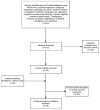Metabolic In Vivo Visualization of Pituitary Adenomas: a Systematic Review of Imaging Modalities
- PMID: 28461279
- PMCID: PMC5821230
- DOI: 10.1016/j.wneu.2017.04.128
Metabolic In Vivo Visualization of Pituitary Adenomas: a Systematic Review of Imaging Modalities
Abstract
Objective: Pituitary adenomas (PAs) are the most common intrasellar mass. Functional PAs constitute most of pituitary tumors and can produce symptoms related to hormonal overproduction. Timely and accurate detection is therefore of vital importance to prevent potentially irreversible sequelae. Magnetic resonance imaging is the gold standard for detecting PAs, but is limited by poor sensitivity for microadenomas and an inability to differentiate scar tissue from tumor residual or predict treatment response. Several new modalities that detect PAs have been proposed.
Methods: A systematic review of the PubMed database was performed for imaging studies of PAs since its inception. Data concerning study characteristics, clinical symptoms, imaging modalities, and diagnostic accuracy were collected.
Results: After applying exclusion criteria, 25 studies of imaging PAs using positron emission tomography (PET), magnetic resonance spectroscopy (MRS), and single photon emission computed tomography were reviewed. PET reliably detects PAs, particularly where magnetic resonance imaging is equivocal, although its efficacy is limited by high cost and low availability. Single photon emission computed tomography possesses good sensitivity for neuroendocrine tumors but its use with PAs is poorly documented. MRS consistently detects cellular proliferation and hormonal activity, but warrants further study at higher magnetic field strength.
Conclusions: PET and MRS appear to have the strongest predictive value in detecting PAs. MRS has the advantage of low cost, but the literature is lacking in specific studies of the pituitary. Due to high recurrence rates of functional PAs and low sensitivity of existing diagnostic workups, further investigation of metabolic imaging is necessary.
Keywords: Functional pituitary adenoma; Hormonally active pituitary adenoma; Magnetic resonance spectroscopy; Metabolic imaging; Positron emission tomography; Single photon emission computed tomography.
Copyright © 2017 Elsevier Inc. All rights reserved.
Figures




Similar articles
-
A contemporary, multiinstitutional analysis of transcription factor lineage in pituitary adenomas: comparative study of neuroimaging, histopathology, and clinical outcomes.J Neurosurg. 2025 Mar 14;143(1):146-154. doi: 10.3171/2024.10.JNS24853. Print 2025 Jul 1. J Neurosurg. 2025. PMID: 40085941
-
Structural neuroimaging in psychosis: a systematic review and economic evaluation.Health Technol Assess. 2008 May;12(18):iii-iv, ix-163. doi: 10.3310/hta12180. Health Technol Assess. 2008. PMID: 18462577
-
Congress of Neurological Surgeons Systematic Review and Evidence-Based Guideline on Preoperative Imaging Assessment of Patients With Suspected Nonfunctioning Pituitary Adenomas.Neurosurgery. 2016 Oct;79(4):E524-6. doi: 10.1227/NEU.0000000000001391. Neurosurgery. 2016. PMID: 27635958
-
Fluorine-18-fluorodeoxyglucose (FDG) positron emission tomography (PET) computed tomography (CT) for the detection of bone, lung, and lymph node metastases in rhabdomyosarcoma.Cochrane Database Syst Rev. 2021 Nov 9;11(11):CD012325. doi: 10.1002/14651858.CD012325.pub2. Cochrane Database Syst Rev. 2021. PMID: 34753195 Free PMC article.
-
Magnetic resonance perfusion for differentiating low-grade from high-grade gliomas at first presentation.Cochrane Database Syst Rev. 2018 Jan 22;1(1):CD011551. doi: 10.1002/14651858.CD011551.pub2. Cochrane Database Syst Rev. 2018. PMID: 29357120 Free PMC article.
Cited by
-
Challenges and opportunities for new intraoperative optical techniques in the surgical treatment of pituitary adenomas: a review.J Biomed Opt. 2025 Aug;30(8):080901. doi: 10.1117/1.JBO.30.8.080901. Epub 2025 Aug 13. J Biomed Opt. 2025. PMID: 40808829 Free PMC article. Review.
-
Ex Vivo 1H NMR study of pituitary adenomas to differentiate various immunohistochemical subtypes.Sci Rep. 2019 Feb 28;9(1):3007. doi: 10.1038/s41598-019-38542-6. Sci Rep. 2019. PMID: 30816132 Free PMC article.
-
Elevated levels of circulating betahydroxybutyrate in pituitary tumor patients may differentiate prolactinomas from other immunohistochemical subtypes.Sci Rep. 2020 Jan 28;10(1):1334. doi: 10.1038/s41598-020-58244-8. Sci Rep. 2020. PMID: 31992791 Free PMC article.
-
Case Report and Literature Review: Ectopic Thyrotropin-Secreting Pituitary Adenoma in the Suprasellar Region.Front Endocrinol (Lausanne). 2021 Mar 11;12:619161. doi: 10.3389/fendo.2021.619161. eCollection 2021. Front Endocrinol (Lausanne). 2021. PMID: 33776916 Free PMC article. Review.
-
[Neuroendocrine tumors : Classification, clinical presentation and imaging].Radiologe. 2019 Nov;59(11):952-960. doi: 10.1007/s00117-019-0574-x. Radiologe. 2019. PMID: 31359091 Review. German.
References
-
- Chanson P, Raverot G, Castinetti F, et al. Management of clinically non-functioning pituitary adenoma. Ann Endocrinol (Paris) 2015;76(3):239–247. - PubMed
-
- Milker-Zabel S, Debus J, Thilmann C, Schlegel W, Wannenmacher M. Fractionated stereotactically guided radiotherapy and radiosurgery in the treatment of functional and nonfunctional adenomas of the pituitary gland. Int J Radiat Oncol Biol Phys. 2001;50(5):1279–1286. - PubMed
-
- Tang BN, Levivier M, Heureux M, et al. 11C-methionine PET for the diagnosis and management of recurrent pituitary adenomas. European journal of nuclear medicine and molecular imaging. 2006;33(2):169–178. - PubMed
-
- Alzahrani AS, Farhat R, Al-Arifi A, Al-Kahtani N, Kanaan I, Abouzied M. The diagnostic value of fused positron emission tomography/computed tomography in the localization of adrenocorticotropin-secreting pituitary adenoma in Cushing’s disease. Pituitary. 2009;12(4):309–314. - PubMed
-
- Chanson P, Salenave S. Diagnosis and treatment of pituitary adenomas. Minerva endocrinologica. 2004;29(4):241–275. - PubMed
Publication types
MeSH terms
Substances
Grants and funding
LinkOut - more resources
Full Text Sources
Other Literature Sources
Medical

